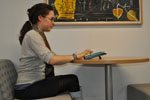January 26, 2012 — People worldwide have been buying up tablet computers—small, thin devices such as Apple’s iPad–in droves, partly because of their ease of use and portability. However, little is known about the potential for tablet users to experience the same kinds of ergonomic issues that have afflicted desktop computer users for decades, such as head, neck, and wrist pain. Now, in an article published in Work: A Journal of Prevention, Assessment, and Rehabilitation, on January 15, 2012, Harvard School of Public Health researchers have begun quantifying the ways in which a person’s posture, and also the design of the tablet and its case, affect comfort—evidence that will help companies develop new ergonomic guidelines as tablets become more common in the workplace.
Photos are recreations of the postures researchers studied in laboratory volunteers.
“The beauty of tablets and other mobile devices is their flexibility,” said lead author Jack Dennerlein, director of the Occupational Biomechanics and Ergonomics Laboratory at HSPH. “You can use them almost anywhere and in different ways. You can hold them in your lap; you can hold them in your hand. The problem is that some of the postures people are in when using a tablet can be awkward and lead to discomfort with prolonged use.”
To conduct the study, Dennerlein and colleagues from HSPH, Microsoft Corporation, and Brigham and Women’s Hospital, brought fifteen experienced tablet users into the lab to complete a set of simulated tasks on an Apple iPad2 and a Motorola Xoom. All of the volunteers were adults under 40. Each tablet had a proprietary case that could be adjusted to prop up the tablet at an angle.
During the experiment, users were situated in four postures: Lap-Hand (tablet held on lap); Lap-Case (tablet placed on lap in case at its lower angle setting—15 degrees for the iPad and 45 degrees for the Xoom); Table-Case (tablet placed on table with its case at its lower angle setting); and Table-Movie (tablet placed on table in case at its higher angle setting—73 degrees for the iPad and 63 degrees for the Xoom). While users browsed the Internet, responded to email, played games, and watched a movie, their head and neck posture and gaze angle were measured using an infrared three-dimensional motion analysis system.
The researchers found that study participants’ heads and necks were in more flexed positions while using the tablets than those typical of desktop or notebook computer users. Working for long periods of time with the head slumped forward and the neck flexed can result in neck pain. Users held their heads in the most neutral positions when sitting in the Table-Movie configuration.
Dennerlein recommends that tablet users vary their postures every 15 minutes, and that they use a case that doubles as a tablet stand. These cases reduce the need to grip the device, and also allow it to be propped up at an angle that keeps the user’s head in a neutral position, minimizing neck strain.
An upcoming paper will focus on hand and wrist postures during tablet use. Dennerlein also hopes to study the ergonomics of the tablet’s touchscreen interface, which replaces the desktop computer’s keyboard and mouse.
“These devices are changing the way we interface with computers,” Dennerlein said. “Our results will be useful for updating ergonomic computing standards and guidelines.”



